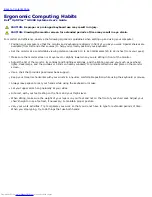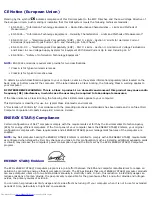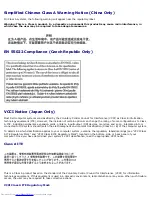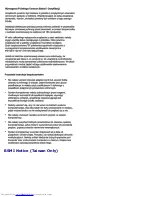
removing a component from the system board or disconnecting a device from the computer.
1. Perform an orderly computer shutdown using the operating system menu.
2. Turn off your computer and any devices connected to the computer.
3. Ground yourself by touching an unpainted metal surface on the chassis, such as the metal around the card-slot
openings at the back of the computer, before touching anything inside your computer.
While you work, periodically touch an unpainted metal surface on the computer chassis to dissipate any static
electricity that might harm internal components.
4. Disconnect your computer and devices, including the monitor, from their electrical outlets. Also, disconnect any
telephone or telecommunication lines from the computer.
Doing so reduces the potential for personal injury or shock.
In addition, take note of these safety guidelines when appropriate:
When you disconnect a cable, pull on its connector or on its strain-relief loop, not on the cable itself. Some cables
have a connector with locking tabs; if you are disconnecting this type of cable, press in on the locking tabs before
disconnecting the cable. As you pull connectors apart, keep them evenly aligned to avoid bending any connector pins.
Also, before you connect a cable, ensure that both connectors are correctly oriented and aligned.
Handle components and cards with care. Do not touch the components or contacts on a card. Hold a card by its edges
or by its metal mounting bracket. Hold a component such as a microprocessor chip by its edges, not by its pins.
CAUTION:
There is a danger of a new battery exploding if it is incorrectly installed. Replace the battery
only with the same or equivalent type recommended by the manufacturer. Do not dispose of the battery
along with household waste. Contact your local waste disposal agency for the address of the nearest
battery deposit site.
Protecting Against Electrostatic Discharge
Static electricity can harm delicate components inside your computer. To prevent static damage, discharge static electricity
from your body before you touch any of your computer's electronic components, such as the microprocessor. You can do so
by touching an unpainted metal surface on the computer chassis.
As you continue to work inside the computer, periodically touch an unpainted metal surface to remove any static charge
your body may have accumulated.
You can also take the following steps to prevent damage from electrostatic discharge (ESD):
Do not remove components from their antistatic packing material until you are ready to install the component in your
computer. Just before unwrapping the antistatic packaging, discharge static electricity from your body.
When transporting an electrostatic sensitive component, first place it in an antistatic container or packaging.
Handle all electrostatic sensitive components in a static-safe area. If possible, use antistatic floor pads and workbench
pads.
Ergonomic Computing Habits
CAUTION:
Improper or prolonged keyboard use may result in injury.
CAUTION:
Viewing the monitor screen for extended periods of time may result in eye strain.
Summary of Contents for GX260 - Optiplex Pentium 4 2.0GHz 512MB 40GB CD
Page 6: ......
Page 29: ......
Page 37: ...Back to Contents Page ...
Page 40: ...information on resetting the chassis intrusion detector Back to Contents Page ...
Page 73: ......
Page 76: ......
Page 86: ...2 padlock ring 3 two release buttons one on each side Back to Contents Page ...
Page 111: ......
Page 128: ...1 release buttons 2 security cable slot 3 padlock ring Back to Contents Page ...
Page 155: ...Back to Contents Page ...
Page 186: ...Back to Contents Page ...
Page 210: ...Back to Contents Page ...
Page 232: ...BSMI Notice Taiwan Only ...














































